These Medieval German towns, nestled within the heart of Europe, are a testament to a bygone era of history and culture. These picturesque settlements, characterized by their charming half-timbered houses, cobbled streets, and fortified walls, offer a captivating glimpse into the past.
During the Middle Ages, these towns played a vital role in shaping the social, economic, and political landscape of the region. Each town bore its unique character and history, from the bustling trade hubs along the Rhine to the idyllic, secluded villages nestled in the Black Forest.
Medieval German Towns
Exploring these medieval German towns is like stepping back in time, where the echoes of centuries-old stories resonate through the narrow alleys and town squares, making them a must-visit destination for history enthusiasts and travellers seeking a taste of Germany’s rich heritage.
Note that, given the title of the post, these are all medieval “towns” and no cities are included.
Rothenburg ob der Tauber
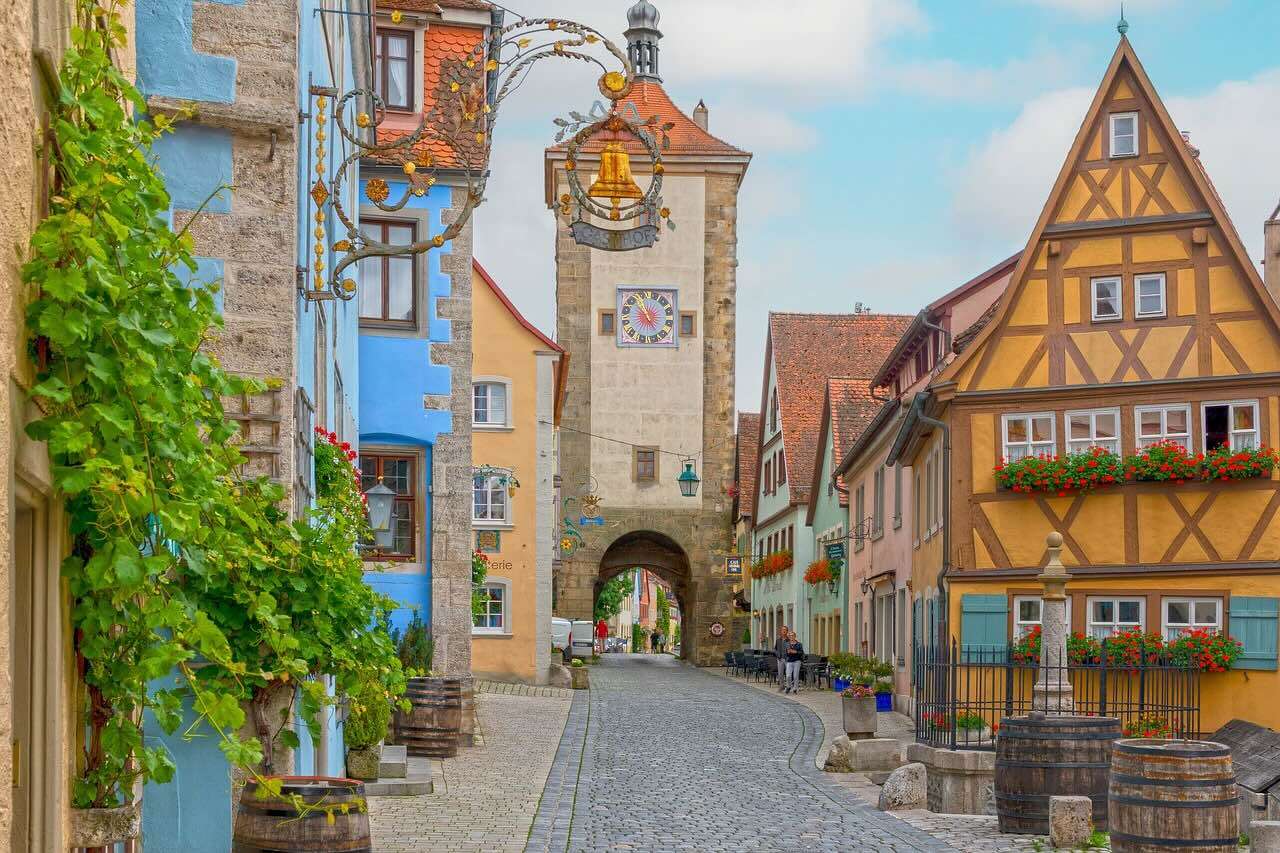
Rothenburg ob der Tauber is a picturesque medieval town located in Bavaria. It is renowned for its exceptionally well-preserved medieval architecture and its charming old town, which has earned it the nickname “Germany’s Christmas Capital.”
Rothenburg ob der Tauber is famous for its perfectly preserved medieval buildings, including well-preserved half-timbered houses, city walls, and fortifications.
The heart of the town is its old town (Altstadt), which is surrounded by city walls. The Marktplatz (market square) is a focal point, featuring the Town Hall (Rathaus) with its impressive tower.
St. James’s Church (St. Jakobskirche) is a prominent landmark in Rothenburg ob der Tauber, known for its stunning interior and a beautiful altar by Tilman Riemenschneider.
The Medieval Crime and Justice Museum offers insights into the history of crime and punishment in medieval Europe. It displays various instruments of torture and criminal justice artefacts.
Rothenburg ob der Tauber is famous for its Christmas markets, which attract visitors from around the world. The market transforms the town into a festive wonderland during the holiday season.
The town is surrounded by well-preserved city walls, and visitors can take a stroll along them to enjoy panoramic views of the town and the Tauber River valley.
Traditional German and Franconian cuisine is readily available in Rothenburg ob der Tauber. You can savour regional dishes such as sausages, schnitzel, and other local specialities.
The Night Watchman’s guided tours in the evening provide an entertaining and informative look into the town’s history and folklore.
Rothenburg ob der Tauber’s timeless charm and well-preserved medieval atmosphere make it a popular destination for tourists who want to experience a piece of medieval Germany and enjoy its rich history and culture.
Out of all these medieval German towns to visit be sure to add this one to the top of your list.
Book accommodation in Rothenburg ob der Tauber here.
Quedlinburg
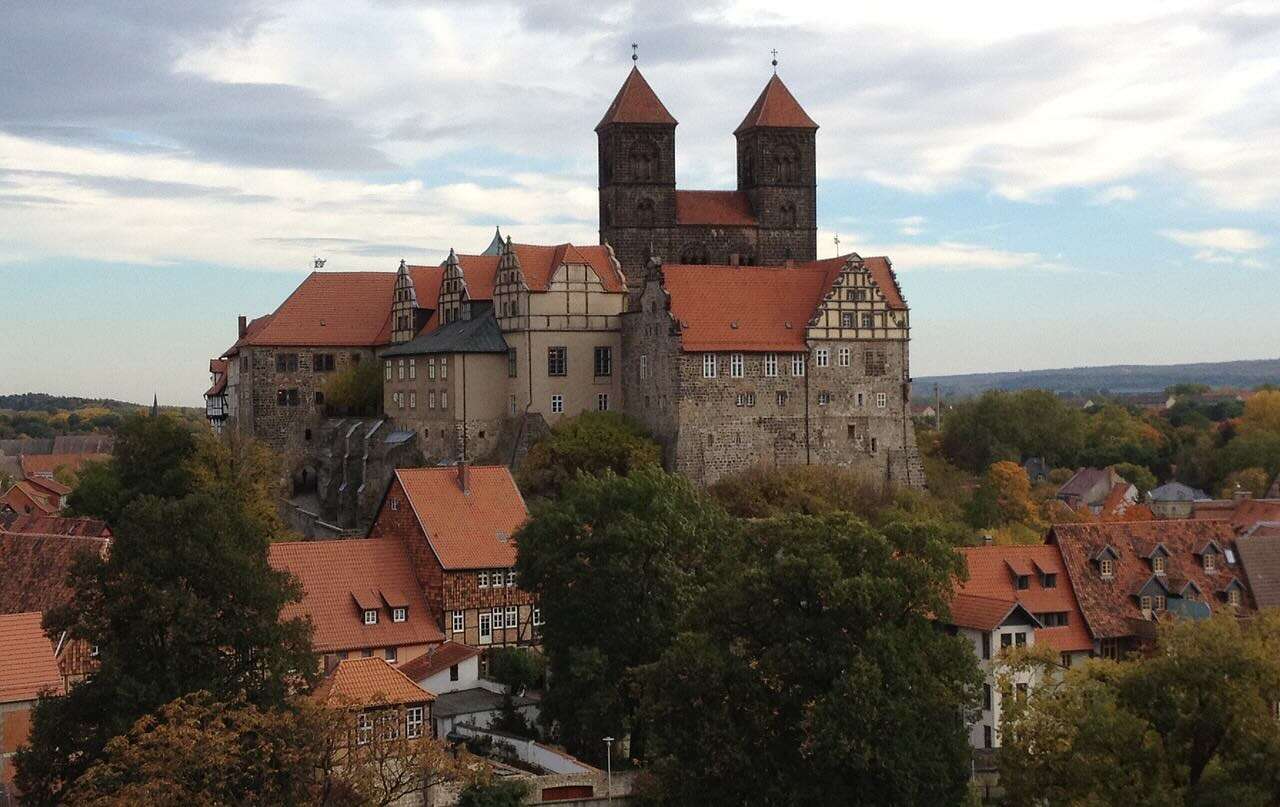
Quedlinburg is a historic town located in the Harz Mountains of Saxony-Anhalt. It is renowned for its exceptionally well-preserved medieval and Renaissance architecture.
The entire old town of Quedlinburg is a UNESCO World Heritage Site due to its well-preserved medieval and Renaissance architecture. It is considered one of the best-preserved medieval towns in Germany.
High above the town, the Quedlinburg Castle (Burg Quedlinburg) provides panoramic views of the surrounding area. The castle complex includes several historical buildings and museums.
Quedlinburg is famous for its timber-framed houses, which are beautifully preserved and add to the town’s unique character. Many of these houses date back to the Middle Ages.
The Fachwerkmuseum Ständerbau museum is dedicated to timber-framed architecture and provides insights into the construction techniques used in Quedlinburg’s historic buildings.
The former Quedlinburg Abbey is another UNESCO-listed site, with its history dating back to the 9th century. It includes the collegiate church of St. Servatius.
This is easily one of the best medieval German towns that you can visit.
Book accommodation in Quedlinburg here.
Bamberg
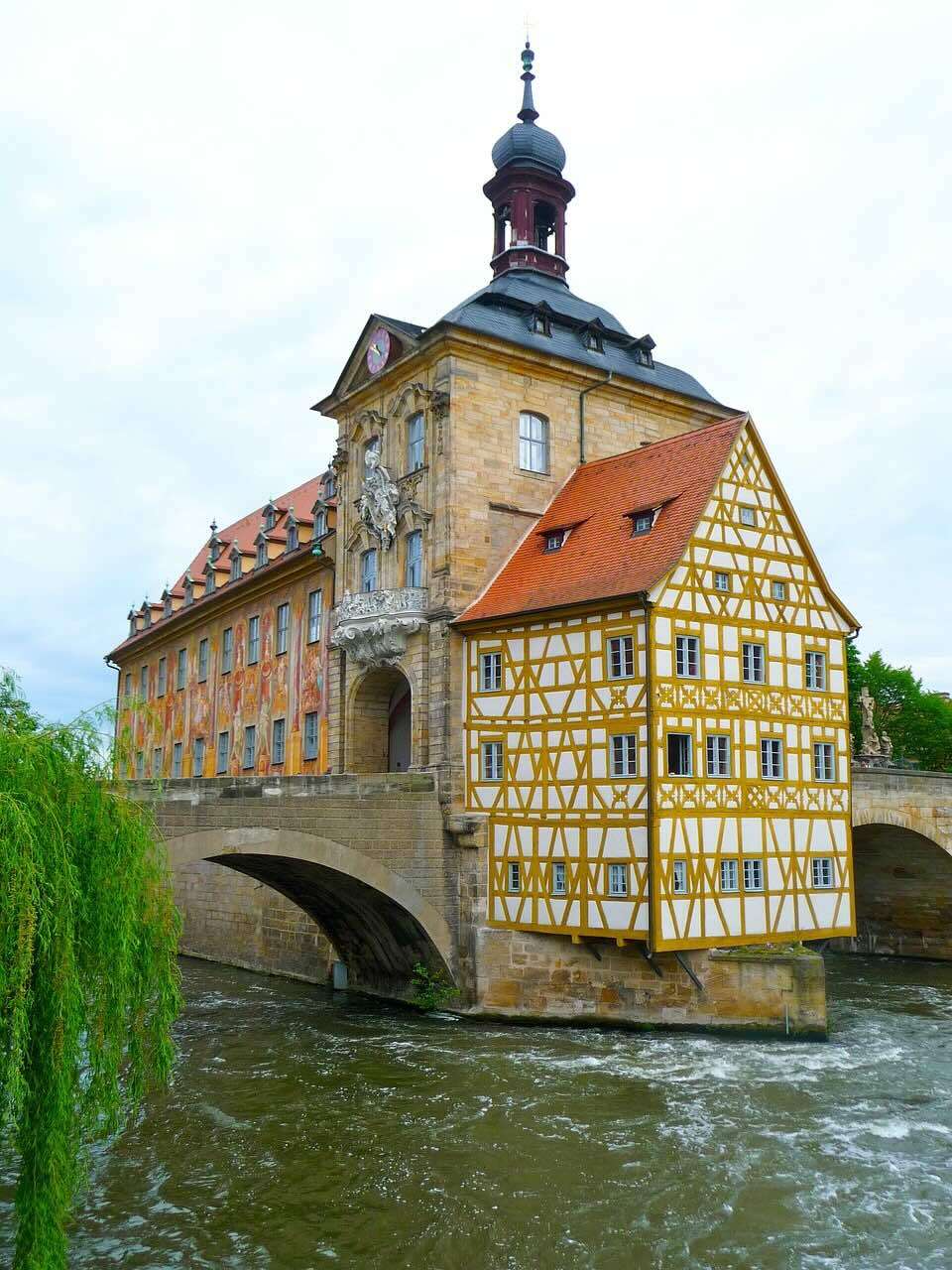
Bamberg is a picturesque town located in the Franconia region of Bavaria. Known for its exceptionally well-preserved medieval and Baroque architecture, Bamberg is often referred to as the “Franconian Rome” due to its seven hills and numerous historic buildings.
The entire Old Town of Bamberg is a UNESCO World Heritage Site due to its outstanding cultural heritage and historical significance. The town’s architecture represents a range of styles, from Romanesque to Baroque.
The Altes Rathaus (Old Town Hall) is a unique and beautifully adorned building that straddles the Regnitz River. It is a prime example of medieval architecture and serves as a symbol of Bamberg.
The Bamberg Cathedral (Bamberger Dom) is a majestic Romanesque cathedral that houses the tombs of Emperor Henry II and his wife Cunigunde. It is one of the most iconic landmarks in the town.
A charming section of Bamberg along the Regnitz River is known as “Little Venice” due to its rows of colourful, half-timbered houses that line the riverbanks. It’s a popular spot for picturesque walks and boat rides.
Bamberg is famous for its smoked beer, and one of the most renowned breweries to try it is Schlenkerla. It offers a unique and flavorful beer experience for enthusiasts.
The town is home to the Bamberg Symphony, an internationally recognized orchestra that performs in the Konzerthalle Bamberg, a modern concert hall.
Bamberg is known for its Franconian cuisine, which includes dishes like smoked beer, sausages, and the local speciality, “Schäufele,” a roasted pork shoulder.
Book accommodation in Bamberg here.
Wernigerode

Wernigerode is a charming town located in the Harz Mountains. It is renowned for its well-preserved medieval and timber-framed architecture, which gives the town a picturesque and fairy-tale-like appearance.
At the top of a hill overlooking the town stands Wernigerode Castle (Schloss Wernigerode), an impressive and well-preserved medieval castle. Visitors can explore the castle’s rooms, and gardens, and enjoy panoramic views of the surrounding Harz Mountains.
Wernigerode is famous for its timber-framed houses, many of which date back to the Middle Ages. These houses line the streets of the old town and are beautifully adorned with colourful facades.
The Wernigerode Town Hall (Rathaus) is an architectural gem with a unique design featuring a blend of Gothic, Renaissance, and Baroque styles. It is one of the town’s most iconic landmarks.
Wernigerode serves as the starting point for the Harz Narrow Gauge Railway (Harzer Schmalspurbahnen), a historic steam railway that offers scenic rides through the Harz Mountains. It is a popular attraction for train enthusiasts and tourists.
The town’s market square, Marktplatz, is a vibrant and lively place where you can find cafes, restaurants, and shops. It is often used for local events and festivals.
Wernigerode is located near the Harz National Park, which offers opportunities for outdoor activities such as hiking, mountain biking, and wildlife observation.
Wernigerode is easily one of the best medieval German towns to visit and indeed is one of the favourites of Backpackingman.
Book accommodation in Wernigerode here.
Goslar
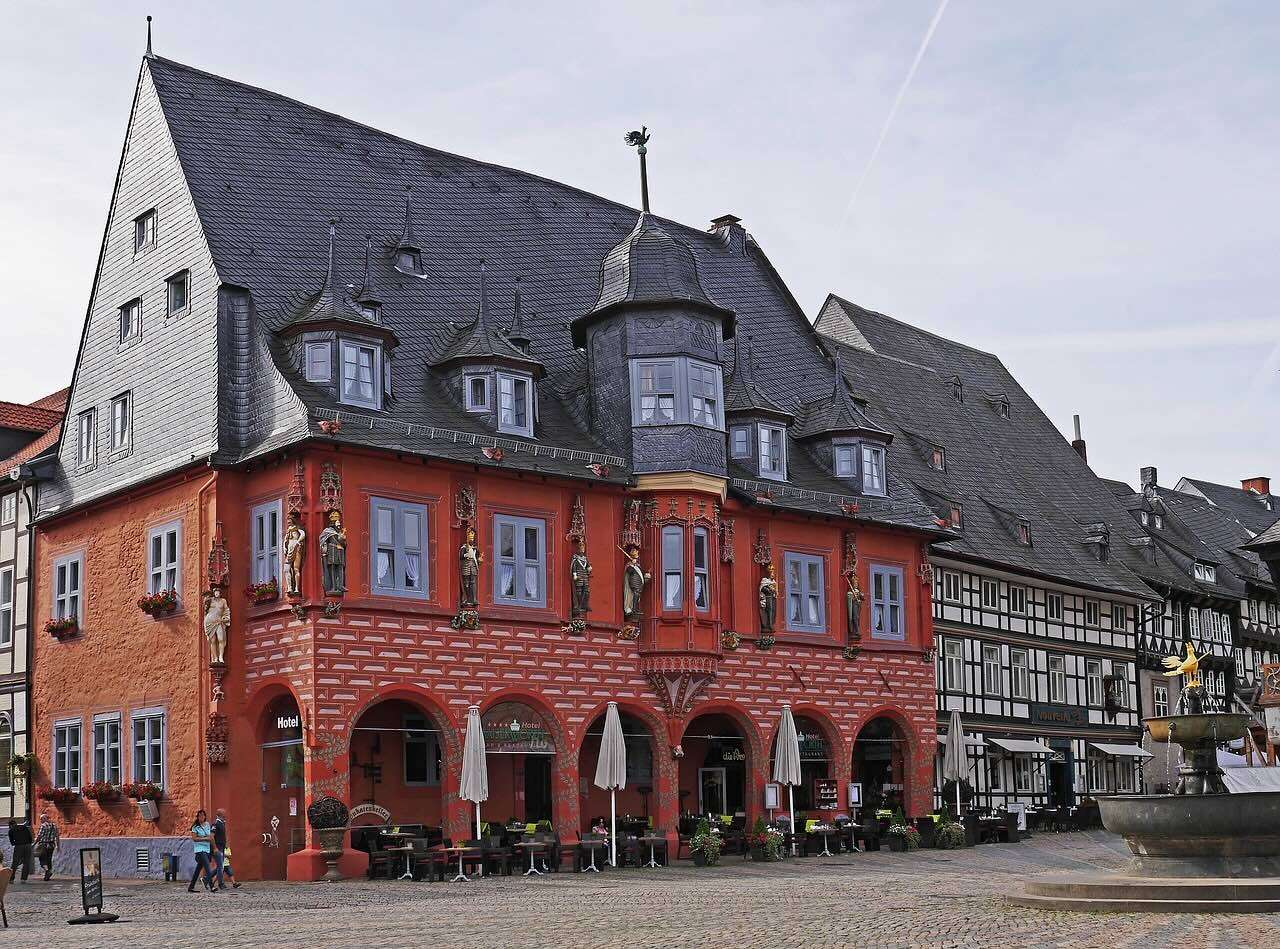
Goslar is a historic town located in the Harz Mountains just like Wernigerode. It is known for its well-preserved medieval and Renaissance architecture, which has earned it a place on the UNESCO World Heritage List.
The historic town centre of Goslar is a UNESCO World Heritage Site due to its exceptional preservation of medieval and Renaissance architecture. It is often referred to as the “Goslar Old Town.”
Goslar is known for its charming half-timbered houses, which line the narrow streets of the town. These buildings create a picturesque and historic atmosphere.
One of the most prominent landmarks in Goslar is the Imperial Palace (Kaiserpfalz), which was used as a residence by various Holy Roman Emperors. Visitors can explore the palace and its impressive architecture.
The town’s central market square, known as the “Marktplatz,” is a focal point for both locals and tourists. It is surrounded by colourful houses, cafes, and shops.
The Rammelsberg mines, located just outside of Goslar, were once a significant source of silver, copper, and lead. The mines are also a UNESCO World Heritage Site and are open to the public for tours, providing insights into the history of mining in the region.
The Harz Mountains offer numerous opportunities for outdoor activities, including hiking and mountain biking. There are many trails in the area, making it a popular destination for nature enthusiasts.
Book accommodation in Goslar here.
Monschau
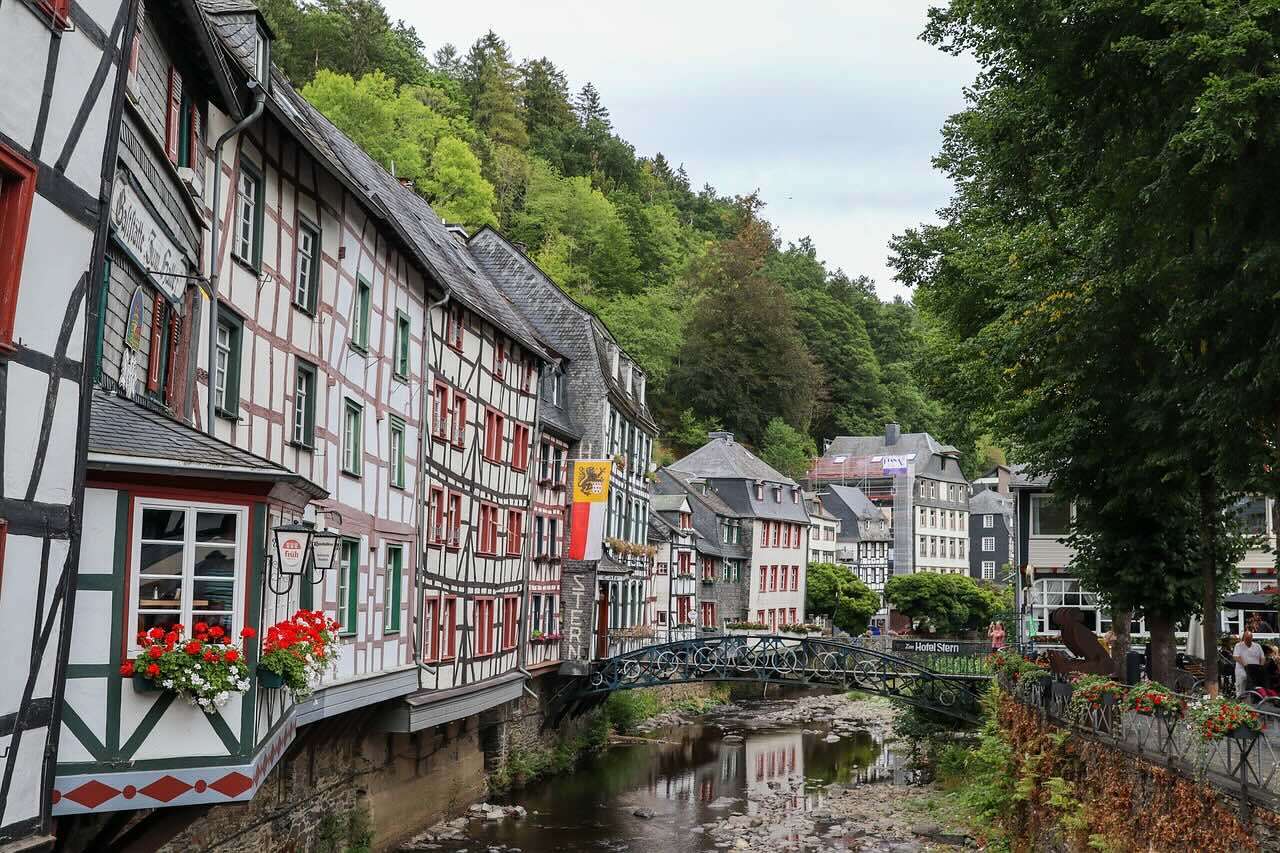
Monschau is a picturesque town located in the North Rhine-Westphalia region of Germany. It is known for its well-preserved half-timbered houses, narrow cobblestone streets, and charming, historic architecture.
Monschau is situated in the Eifel Mountains, near the border with Belgium.
The town’s most notable feature is its beautiful half-timbered houses, many of which date back to the 17th and 18th centuries. These buildings give Monschau a timeless and romantic ambience.
The Red Castle (Rotes Schloss) is a historical building in Monschau that houses the Monschau Cultural History Museum. It provides insights into the town’s history and the Eifel region.
The surrounding Eifel National Park offers opportunities for hiking, cycling, and exploring the natural beauty of the region. There are several scenic trails and paths in the area.
You can enjoy traditional German and regional cuisine in the town’s restaurants and cafes. Dishes like sausages, sauerbraten, and schnitzel are commonly served.
Monschau’s unique blend of history, culture, and natural beauty makes it a popular destination for tourists seeking a charming place out of the medieval German towns to choose from.
Book accommodation in Monschau here.
Cochem
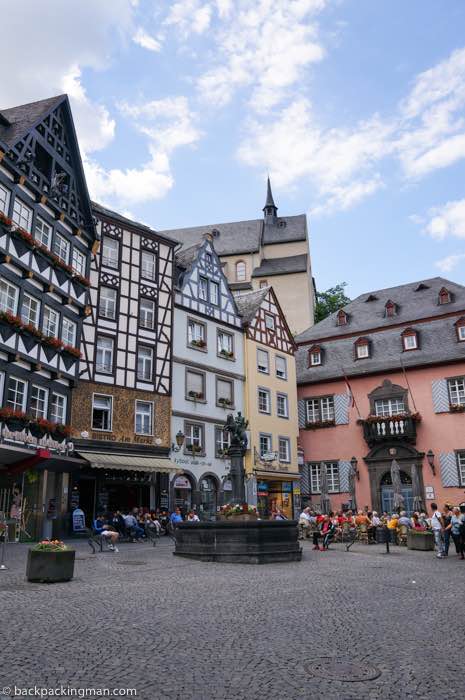
Cochem is a picturesque town located in the Rhineland-Palatinate region of Germany. It is situated on the banks of the Moselle River and is known for its charming old town, historic architecture, and its stunning hilltop castle, Reichsburg Cochem.
The most iconic landmark in Cochem is Reichsburg Cochem, a medieval castle that dates back to the 11th century. The castle is perched on a hill overlooking the town and the Moselle River, offering breathtaking views of the surrounding countryside.
Cochem’s location along the Moselle River makes it a popular destination for river cruises and wine tourism. The region is known for its vineyards and winemaking, and visitors can enjoy scenic boat rides along the river.
Cochem’s historic old town features well-preserved half-timbered houses, narrow cobblestone streets, and charming squares. The town is a popular destination for tourists looking to experience traditional German architecture and culture.
Book accommodation in Cochem here.
Miltenberg
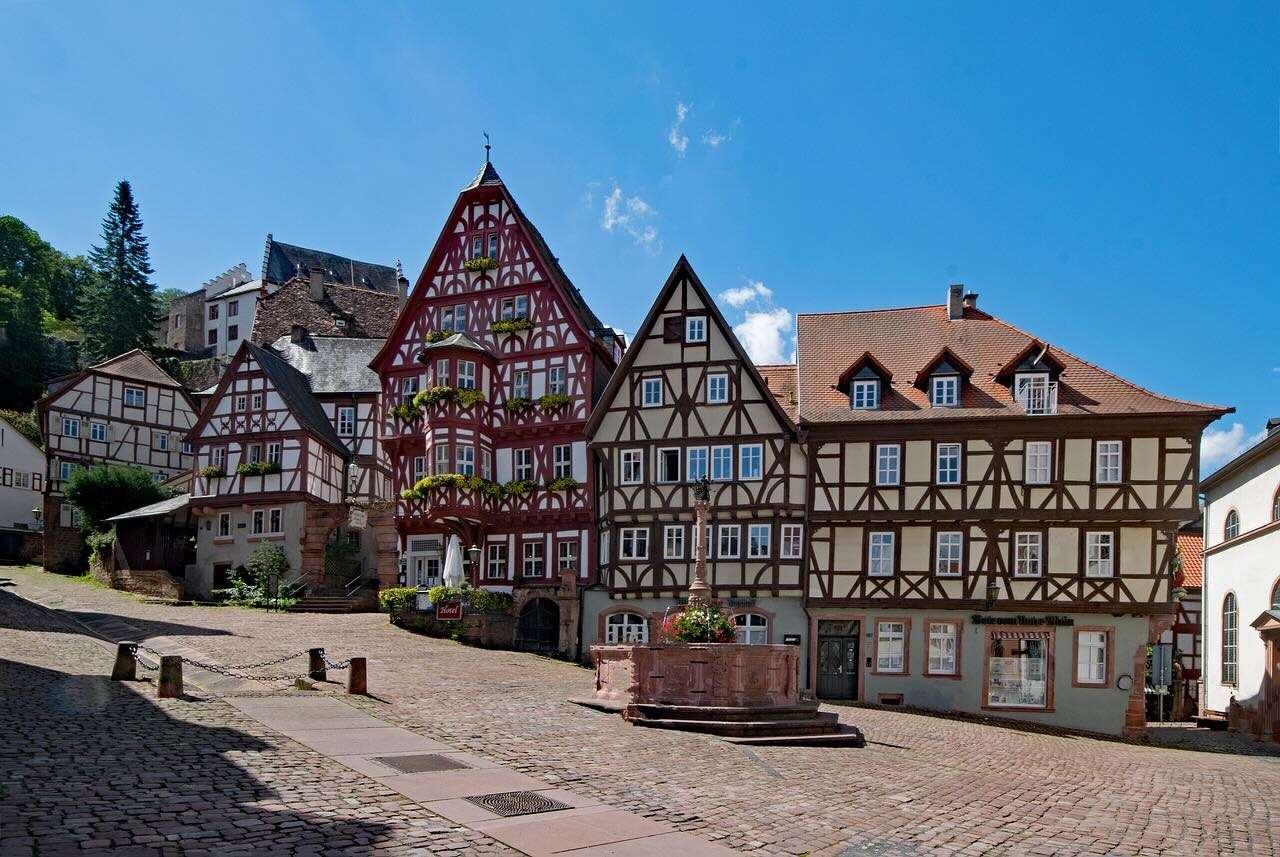
Miltenberg is a historic town in Bavaria known for its well-preserved medieval architecture and its scenic location along the Main River and as being one of the best medieval German towns.
Miltenberg’s old town is a picturesque and well-preserved example of a medieval German town. It features narrow, winding streets, half-timbered houses with colourful facades, and charming squares.
The town’s Market Square (Marktplatz) is a central point in Miltenberg and is surrounded by beautiful historic buildings. It’s a hub for local events, markets, and festivals.
Perched on a hill overlooking the town, Mildenburg Castle is a historic fortress that dates back to the 12th century. It now houses a museum that offers insights into the region’s history and culture.
Miltenberg is situated along the banks of the Main River, and its location is ideal for enjoying river views and outdoor activities.
Winemaking: The surrounding region is part of the Franconian wine country, and Miltenberg itself is known for its vineyards. Wine enthusiasts can visit local wineries and sample the region’s wines.
The town is located in a region with beautiful natural landscapes, making it an excellent starting point for outdoor activities such as hiking and exploring the Spessart Forest, which surrounds Miltenberg.
Miltenberg is a charming and historically significant town in Bavaria, offering a peaceful and authentic German experience in a scenic riverside setting and one of the best medieval German towns to visit.
Book accommodation in Miltenberg here.
Tauberbischofsheim
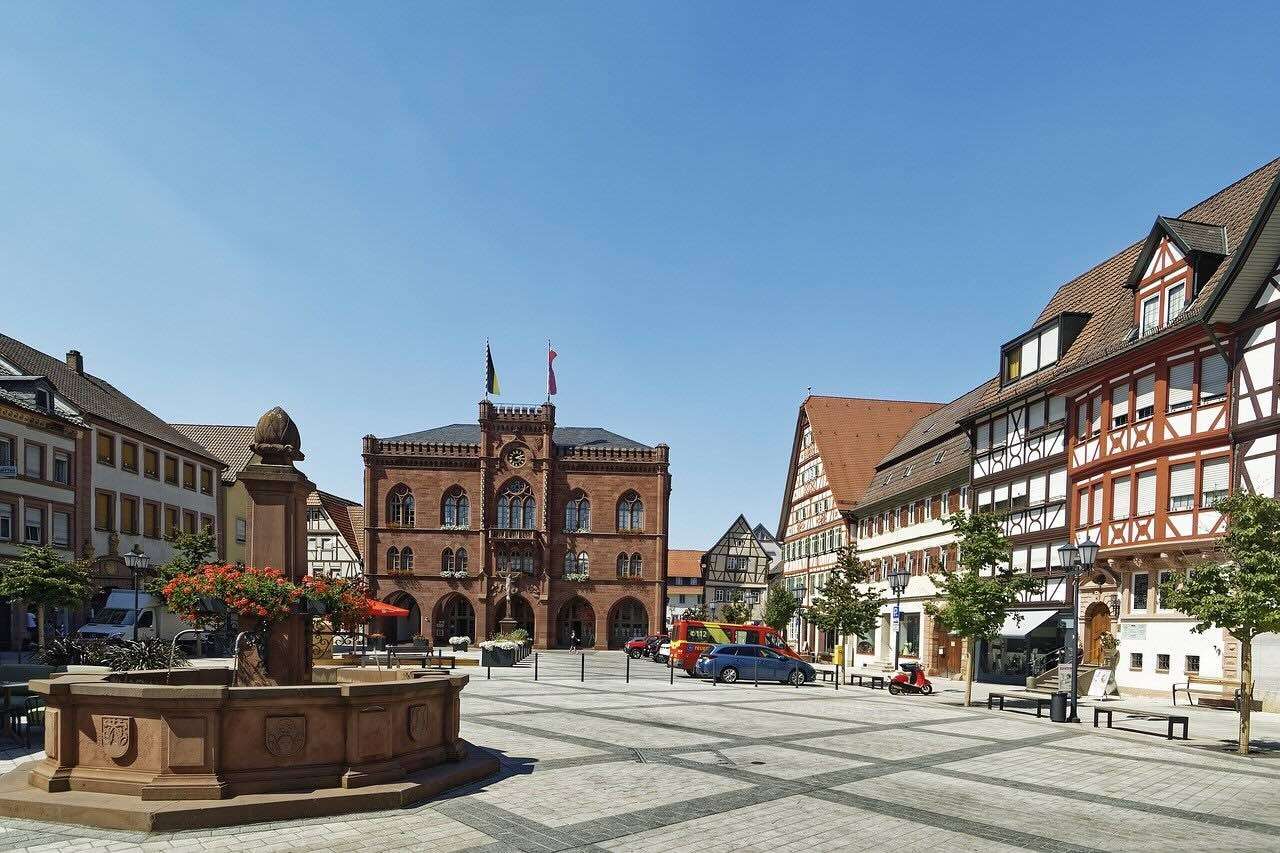
Tauberbischofsheim is situated in the Tauber Valley in the northern part of the Baden-Württemberg state, not far from the border with Bavaria. It is known for its picturesque setting in a valley surrounded by rolling hills and vineyards.
The town has a rich history that dates back to the Middle Ages. It was a centre of trade and commerce along the Tauber River, and historical buildings and structures can be found throughout the town.
Tauberbischofsheim’s old town features well-preserved medieval architecture, including half-timbered houses, narrow streets, and a town square. St. Martin’s Church, a beautiful Gothic church, is one of the town’s notable landmarks.
The surrounding region is part of the Franconian wine country, and Tauberbischofsheim itself is known for its vineyards.
The natural surroundings of Tauberbischofsheim offer opportunities for hiking and cycling, with many scenic routes and trails. The Tauber Valley is known for its beauty and tranquillity.
While Tauberbischofsheim is not as well-known as some other medieval German towns, it does attract tourists who seek a quieter and more authentic experience of German culture and history.
Book accommodation in Tauberbischofsheim here.
Fritzlar
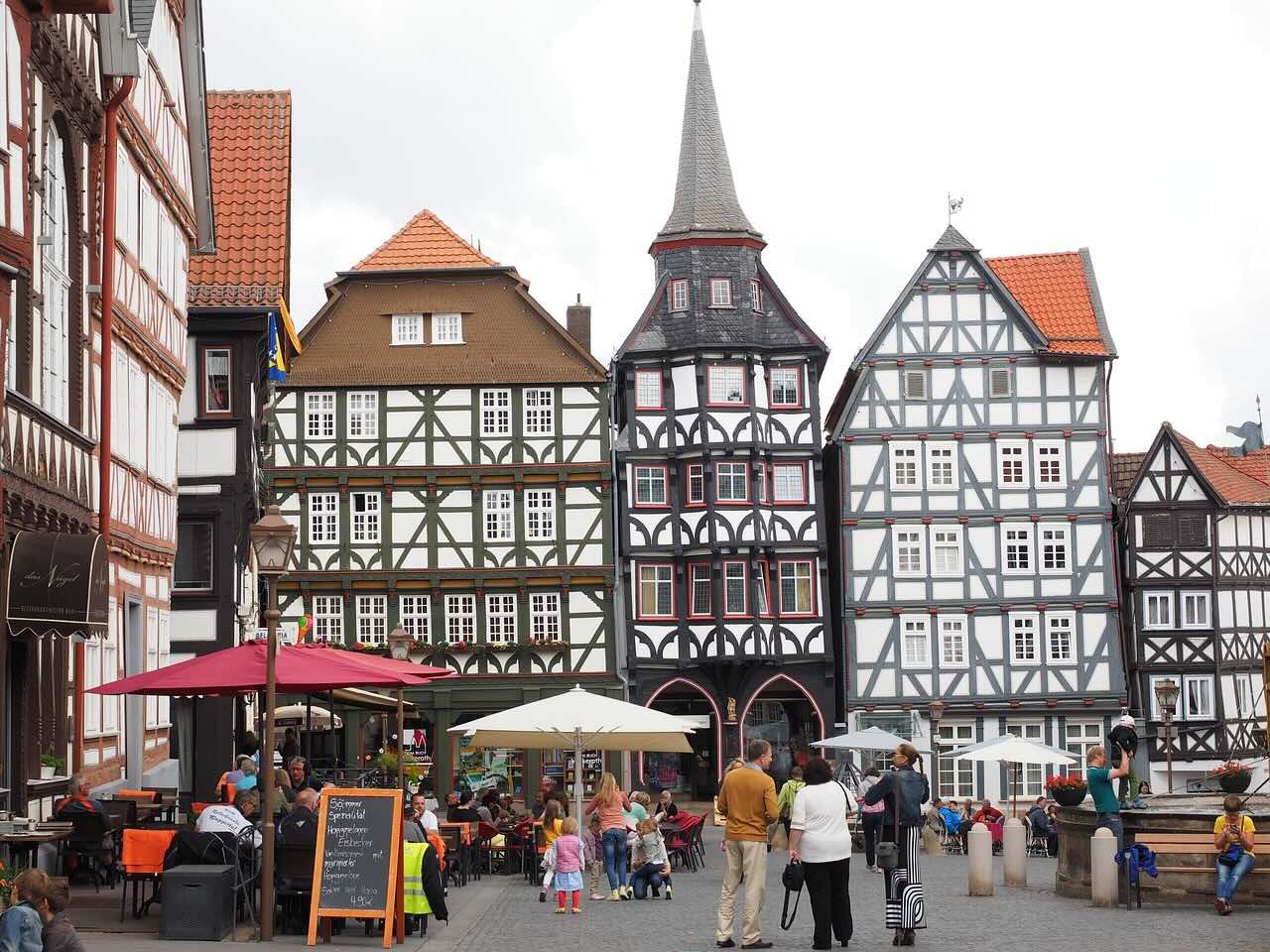
Fritzlar is a historic town located in the northern part of the state of Hesse. It is known for its well-preserved medieval old town, historic buildings, and its significance in German history.
Fritzlar boasts a beautifully preserved medieval old town with narrow cobblestone streets, half-timbered houses, and historic architecture. The old town is surrounded by a well-preserved city wall with towers.
The town’s most prominent landmark is St. Peter’s Cathedral (Dom St. Peter), which dates back to the 11th century. The cathedral is an excellent example of Romanesque architecture and features a striking interior with historical artwork.
The Fritzlar Town Hall (Rathaus) is another architectural gem in the old town, displaying a blend of Gothic and Renaissance styles.
Fritzlar has played a role in German history. It was an important site for trade and commerce in the Middle Ages and is known for its historic connections with Charlemagne (Charles the Great) and other historical figures.
The surrounding area offers opportunities for hiking and exploring the natural beauty of Hesse, including the nearby Habichtswald Nature Park.
Book accommodation in Fritzlar here.
Esslingen
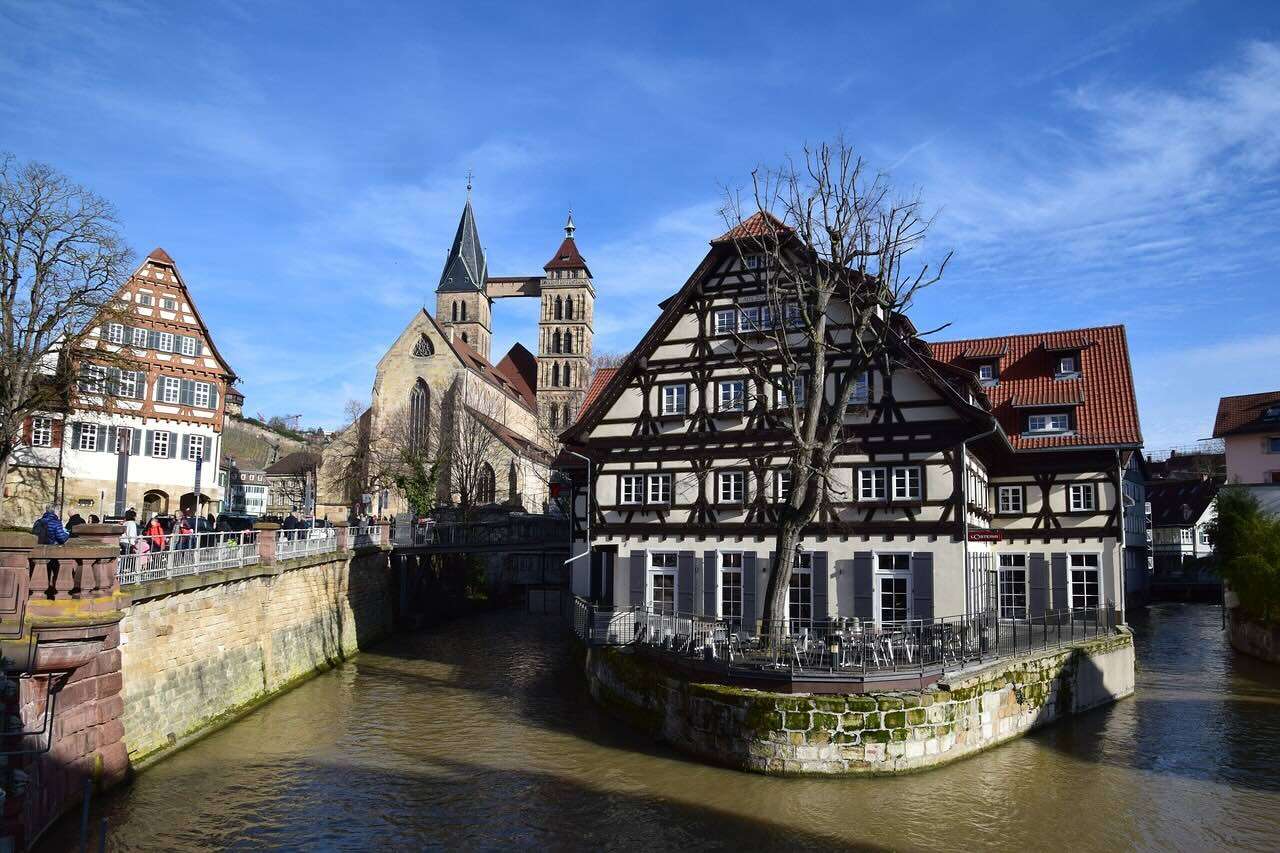
Esslingen, officially known as Esslingen am Neckar, is a picturesque town located in the state of Baden-Württemberg. It is known for its well-preserved medieval old town, historic architecture, and its location along the Neckar River.
Esslingen’s old town is a remarkable and well-preserved example of a medieval German town. It features charming half-timbered houses, narrow streets, and a lively market square with historic buildings.
The Marktplatz in Esslingen is the heart of the town and is surrounded by beautiful buildings, including the Rathaus (Town Hall). The square is a hub for local events, markets, and festivals.
St. Dionysius Church is a notable religious landmark in Esslingen. This impressive Gothic church features a tall steeple and intricate stained glass windows.
The town is known for its numerous medieval buildings and fortifications making it one of the best medieval German towns, including its city walls, towers, and gates that have been well-preserved.
Esslingen is situated in the Neckar Valley, which is known for its vineyards and wine production.
Esslingen am Neckar is a gem of a town that showcases the rich history and culture of Germany.
Book accommodation in Esslingen here.
Nördlingen
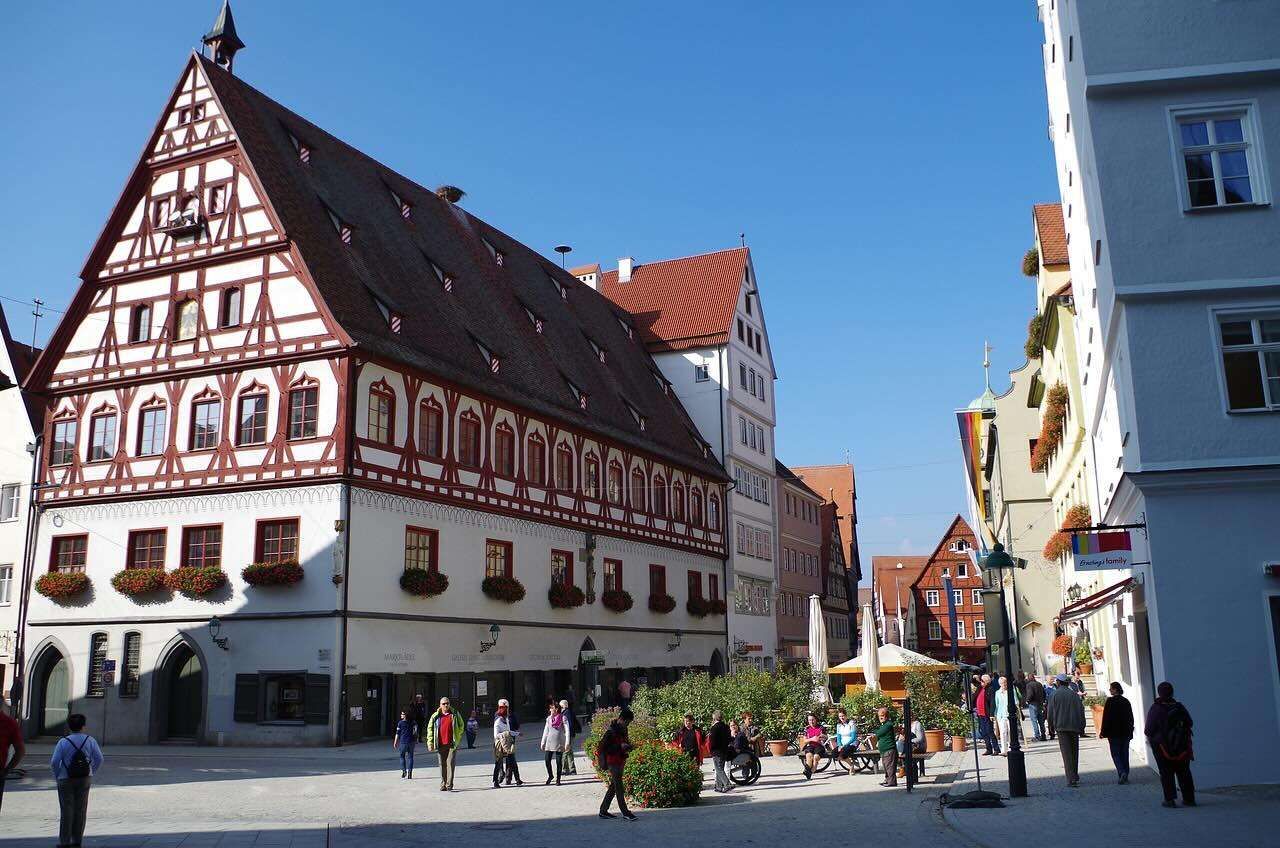
Nördlingen is a historic town located in Bavaria. It is known for its well-preserved medieval architecture, its status as a walled town, and a unique geological feature – the Nördlinger Ries, a massive impact crater from a meteorite strike.
Nördlingen is one of the few towns in Germany that still has its medieval city walls almost entirely intact. The wall, with its fortifications, towers, and gates, encircles the town and is a major attraction for visitors.
One of the most distinctive features of Nördlingen is the Nördlinger Ries, a large impact crater caused by a meteorite strike millions of years ago. The town itself is located within the crater, making it a unique geological site.
St. George’s Church (St. Georgs-Kirche) is a Gothic church in the centre of Nördlingen and is known for its tall steeple, which provides panoramic views of the town and the surrounding countryside.
Nördlingen’s old town is characterized by charming half-timbered houses and cobblestone streets, giving it a distinct medieval ambience.
Book accommodation in Nordlingen here.
Görlitz
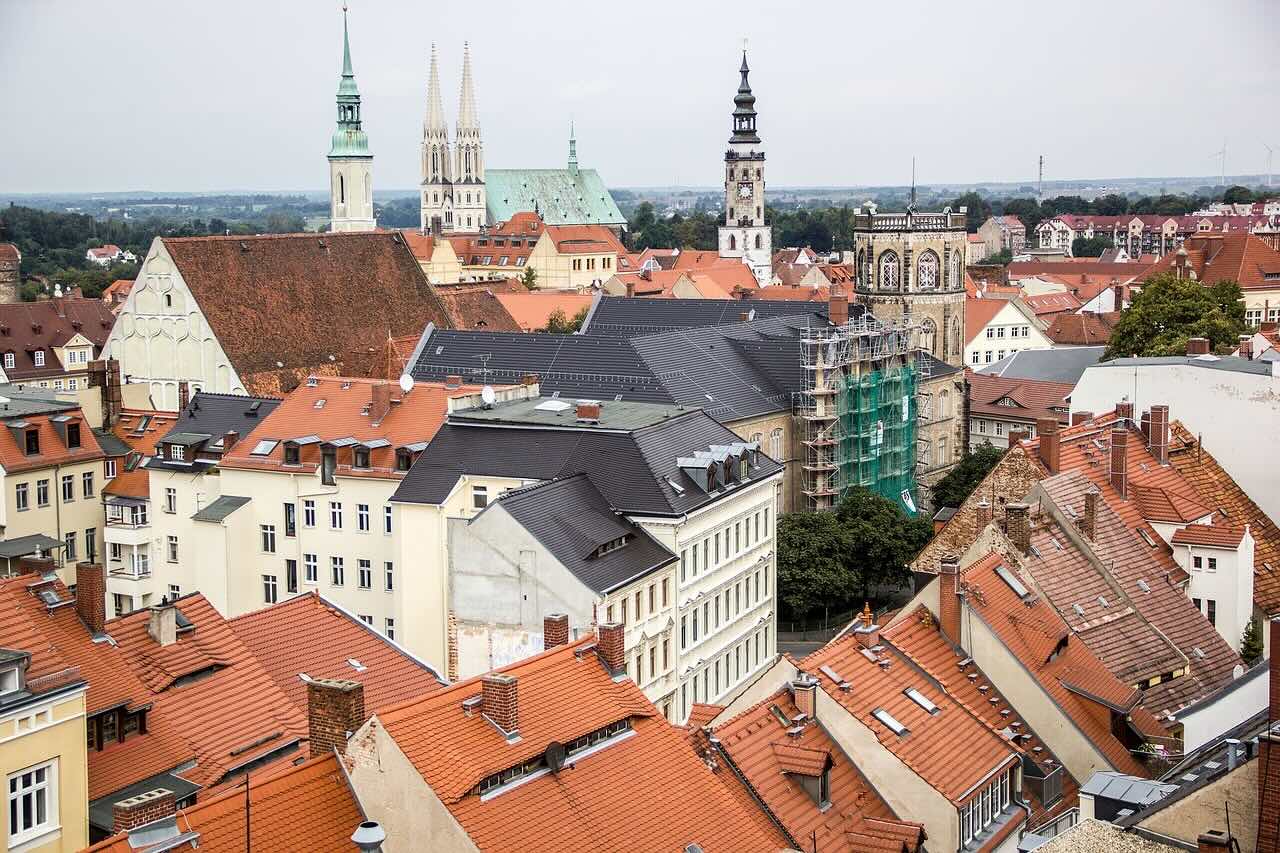
Görlitz is a historic town in the state of Saxony and it is located on the eastern bank of the Neisse River, bordering Poland.
Görlitz is known for its exceptionally well-preserved medieval and Renaissance architecture, making it a popular destination for tourists and filmmakers.
Görlitz’s old town is a treasure trove of beautifully preserved medieval and Renaissance architecture. It boasts numerous ornate buildings, churches, and cobblestone streets, giving it a timeless and picturesque charm.
The Görlitz Old Town Hall is a stunning example of Gothic and Renaissance architecture and serves as a symbol of the town. It features a beautiful arcade courtyard and a tower that offers panoramic views of the town and its surroundings.
St. Peter and Paul’s Church is an impressive late-Gothic church and is one of the most prominent religious landmarks in Görlitz. Its twin towers dominate the skyline of the town.
The Neisse River separates Görlitz from its Polish twin city, Zgorzelec. The picturesque riverbanks and bridges offer opportunities for scenic walks and relaxation.
Görlitz is often referred to as the “Görliwood” due to its increasing popularity as a filming location and is known for its remarkable architectural heritage.
It’s a great place to experience a sense of old-world Europe and is a must-visit for anyone interested in history, culture, and picturesque medieval German towns.
Book accommodation in Gorlitz here.
Schiltach
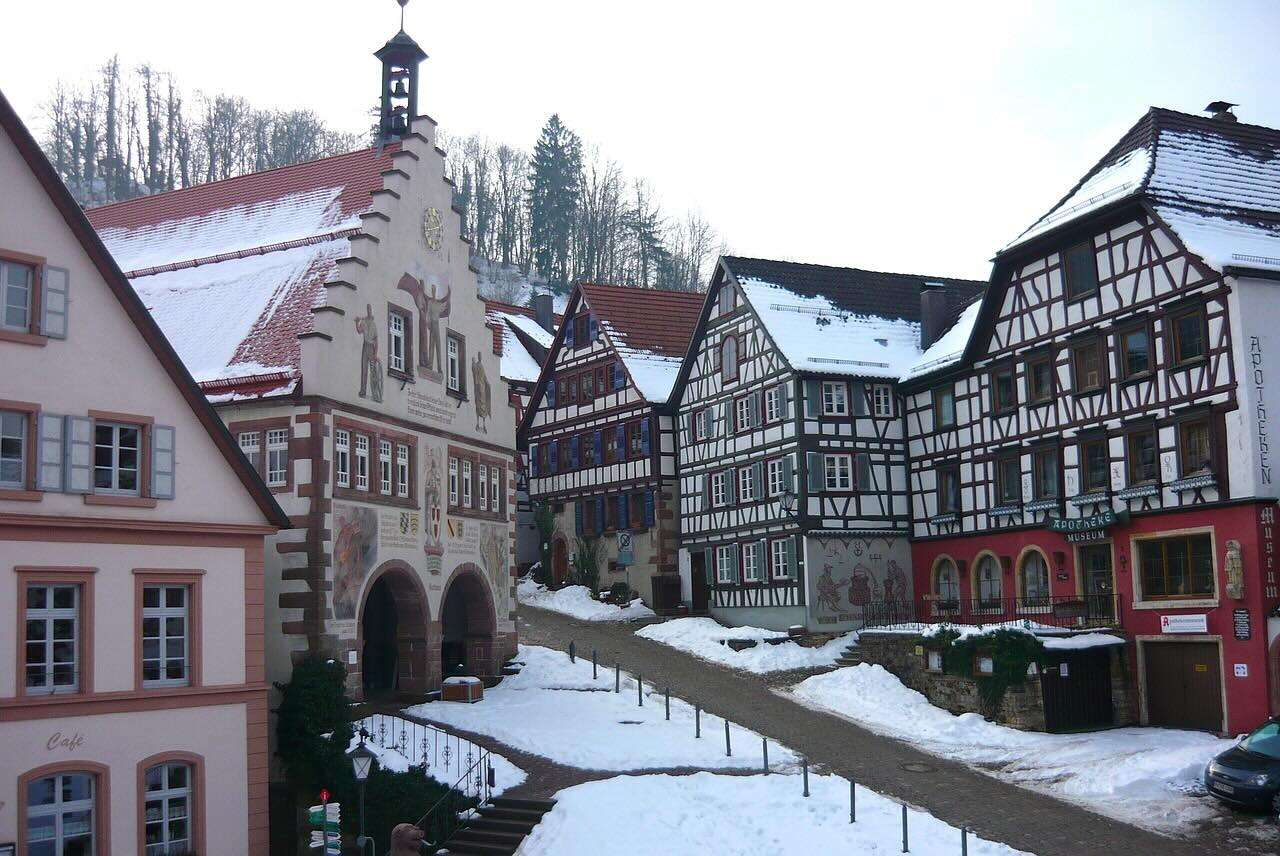
Schiltach is a charming town located in the Black Forest region of Baden-Württemberg. It is known for its well-preserved medieval old town, traditional Black Forest architecture, and its location along the Kinzig River.
Schiltach’s old town is a picturesque example of a medieval German town. It features narrow cobblestone streets, half-timbered houses with colourful facades, and a central market square.
The town’s Market Square (Marktplatz) is surrounded by historic buildings, including the Town Hall (Rathaus) and the St. Michael’s Church (St. Michaelskirche). The square is a focal point for local events and markets.
Schiltach is renowned for its traditional Black Forest-style timber-framed houses, many of which are meticulously preserved. These buildings contribute to the town’s unique charm.
St. Michael’s Church is a prominent religious landmark in Schiltach. The church’s architecture reflects a mix of Gothic and Baroque styles.
The Kinzig River runs through Schiltach, adding to the town’s scenic beauty. You can enjoy walks along the riverbanks and take in the natural surroundings.
The surrounding Black Forest offers a range of outdoor activities, including hiking, cycling, and exploring the beautiful natural landscapes. The area is known for its forested hills and winding trails.
Schiltach is a delightful destination for those seeking an authentic experience of the Black Forest, its culture, and its history.
The well-preserved medieval character and beautiful setting along the Kinzig River make it one of the perfect medieval German towns to explore for the region’s traditions and natural beauty.
Book accommodation in Schiltach here.
Meersburg
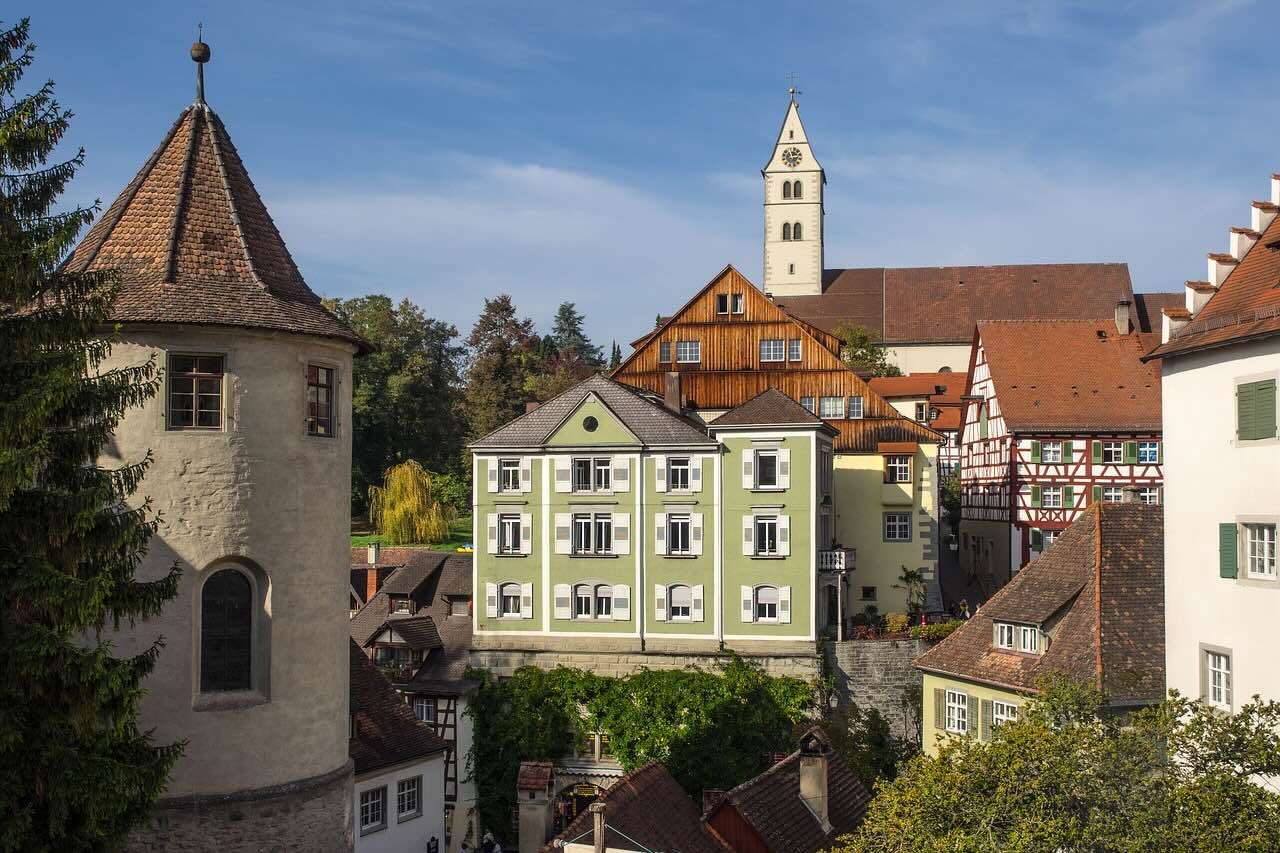
Meersburg is a picturesque town located on the northern shore of Lake Constance (Bodensee) in the state of Baden-Württemberg. It is known for its charming old town, historic architecture, and stunning views of the lake.
Meersburg’s old town is a well-preserved medieval and Renaissance gem, featuring narrow cobblestone streets, half-timbered houses, and historic buildings. The town is divided into an upper town (Oberstadt) and a lower town (Unterstadt).
Meersburg is famous for its medieval castle, Meersburg Castle (Burg Meersburg). The castle is perched on a hill and offers breathtaking views of Lake Constance. It is one of the oldest inhabited castles in Germany and contains a museum showcasing the town’s history.
Meersburg is located on the shores of Lake Constance, one of the largest and most beautiful lakes in Central Europe. The lake offers opportunities for swimming, sailing, and boat trips to other towns on the lake.
The region around Meersburg is known for its vineyards and wine production, particularly the white wine made from the Müller-Thurgau grape variety. You can enjoy wine tastings and explore the local wine culture.
Meersburg is home to the Zeppelin Museum, which displays the history of the Zeppelin airships, a significant part of German aviation history.
If you want to choose from these medieval towns in Germany, one by a lake, then choose Meersburg.
Book accommodation in Meersburg here.
One Extra –
Dinkelsbühl
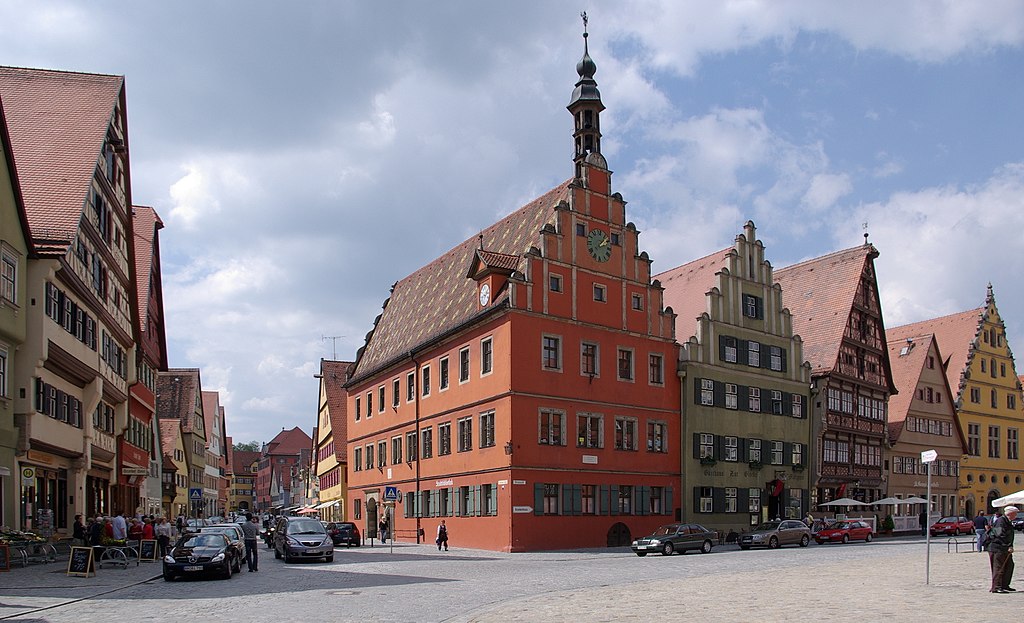
Dinkelsbühl is one of Germany’s best-preserved medieval towns, often described as a living fairy tale. Unlike many other historic centres, Dinkelsbühl’s old town survived the destruction of wars largely intact, leaving behind a rare and authentic glimpse into the Middle Ages.
Its 12th-century walls, complete with watchtowers and gates, still encircle narrow cobbled lanes and half-timbered houses painted in warm pastel hues. At the heart of the town rises St. George’s Minster, a magnificent late Gothic church whose soaring spire dominates the skyline. Walking through its winding streets feels like stepping back in time, where every corner reveals another picture-perfect view.
The town is best known for its annual Kinderzeche festival, a colourful celebration that reenacts how Dinkelsbühl’s children once saved the town from Swedish troops during the Thirty Years’ War. Costumed parades, folk music, and medieval reenactments fill the streets, making July an especially magical time to visit.
Beyond the festivities, you can enjoy cosy cafés tucked into historic buildings, charming boutiques, and peaceful walks along the town walls.
For more on Germany, take a look at the 30 best castles in Germany to visit.
And if you have any interest in medieval history, take a look at these 10 best documentaries about medieval times.
Travel Germany
These medieval German towns offer a diverse range of experiences and showcase the rich history and architecture of medieval Germany.
For a good overall guidebook for Germany, Rick Steves Germany comes highly recommended.
Another good guidebook option is Fodor’s Essential Germany.
Share the best medieval German towns to visit:
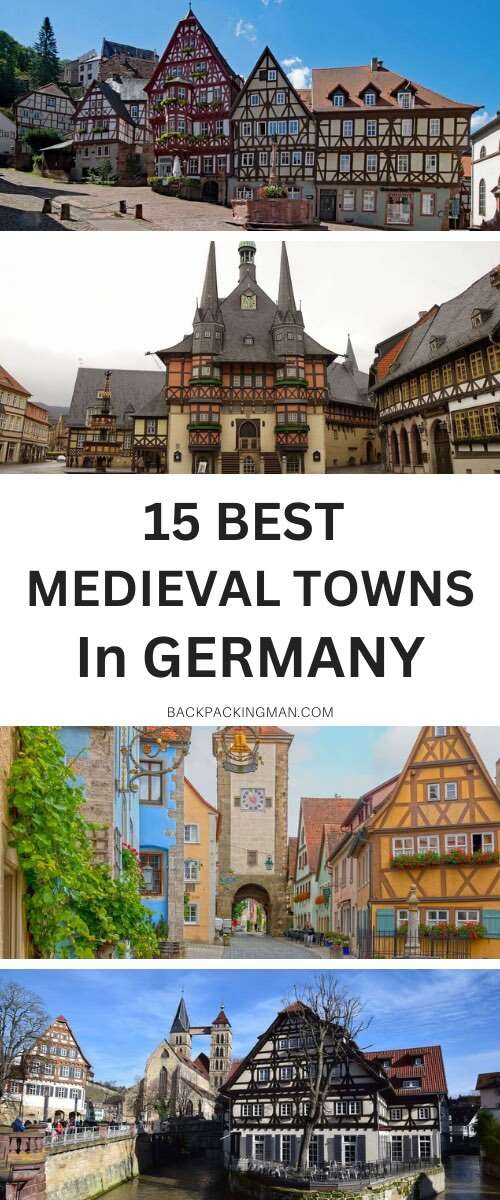





What about Dinkelsbuhl??
Also a beautiful medieval town. I have not visited there myself though. I could actually add loads more to the list as Germany has so many great medieval places, but wanted to keep the list not too long. But, as you mentioned it, and I like to keep my readers happy, I have added it to the list! 🙂